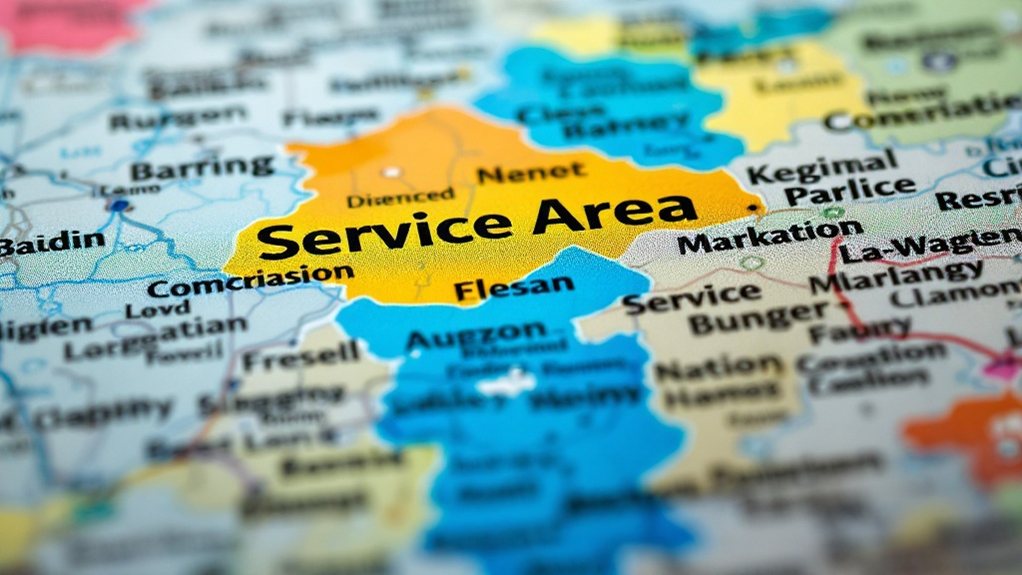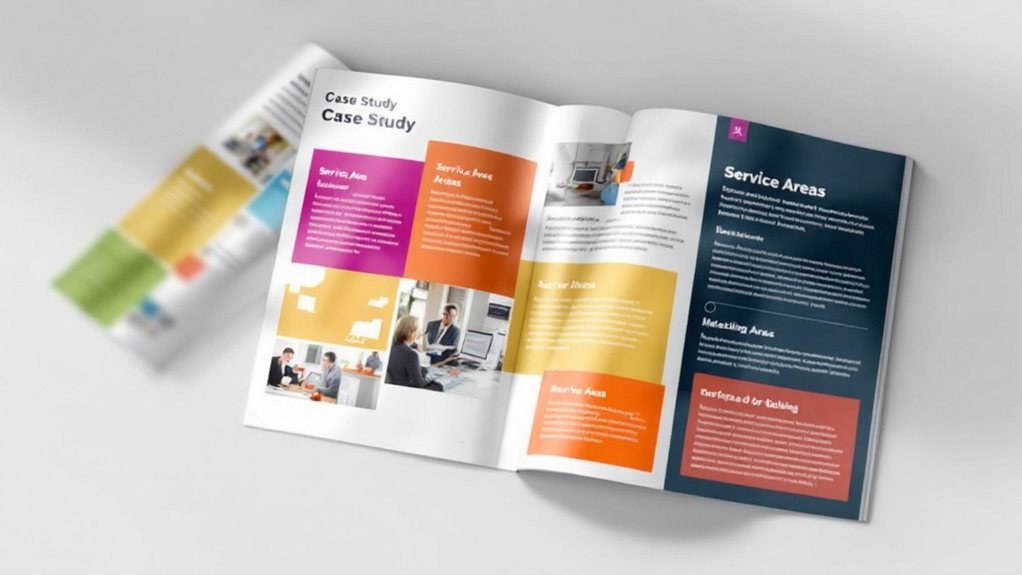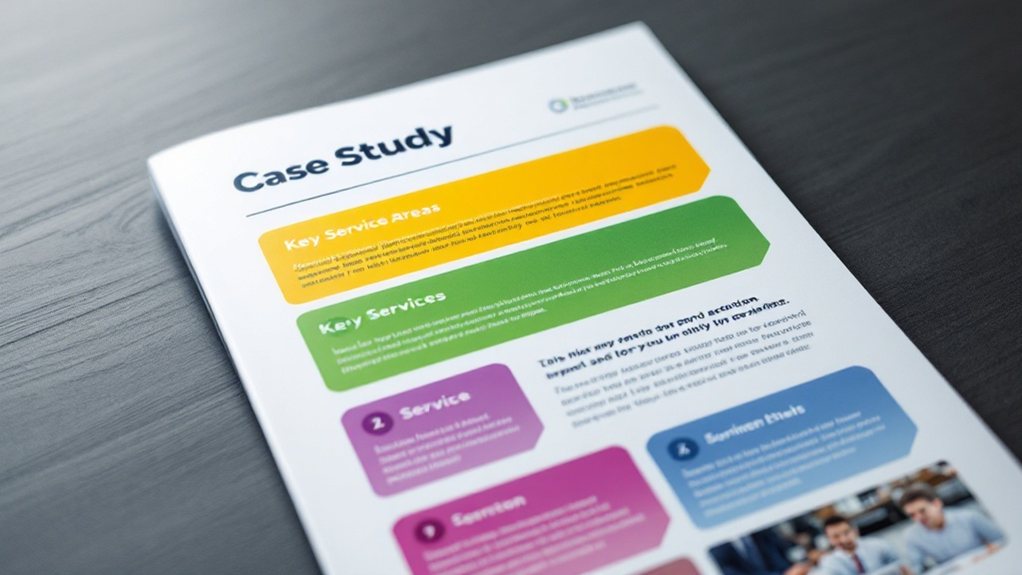To highlight your service areas in case studies, you'll want to frame the specific challenges and objectives aligned with your client's goals. Quantify the outcomes, such as financial savings or time reductions, and tailor the service areas to your target audience's needs. Use concrete examples to illustrate the problem-solution alignment, and showcase your expertise and the value you delivered. By structuring the case study effectively and emphasizing key features, you can create a compelling narrative that resonates with your audience. And if you continue exploring, you'll discover more ways to enhance the credibility of your case studies.
Framing the Service Area

When crafting a case study, you'll want to clearly frame the service areas that your organization addressed. Start by defining the specific challenges and objectives that were tackled, aligning them with your client's goals. Quantify the outcomes, such as financial savings or time reductions, to enhance credibility. Tailor the service areas to your target audience, ensuring the case study resonates with their needs. Use specific examples, like Cortek's steel framing solutions, to illustrate how your services solved critical problems. This problem-solution alignment provides a clear narrative, showcasing your expertise and the value you delivered to the client.
Structuring the Case Study

Structuring the case study is crucial to effectively highlighting your service areas. The introduction and background set the stage, clearly defining the problem and providing critical context. The problem identification and analysis dives deeper, examining the key issues and factors contributing to them. Next, the proposed solutions and recommendations outline specific, realistic strategies to address these problems. The implementation and execution plan details the steps needed to put these solutions into action, considering potential challenges. Uncovering possible solutions and reviewing course materials can help identify the best solution. Finally, the results and evaluation section presents the measurable impact, lessons learned, and long-term benefits. By following this structured approach, you can showcase your service areas' effectiveness in solving complex client problems.
Highlighting Key Features

When showcasing the key features of your product or service, focus on highlighting the specific benefits that address your customers' challenges. Case studies allow highlighting specific benefits and features of offerings in a relatable context. Emphasize what makes your offering distinct and technically superior to the competition. Reinforce your claims with impactful customer testimonials that demonstrate the real-world impact of your key features.
Product/Service Benefits
Highlighting the key benefits of your product or service is crucial in case studies, as it allows you to showcase the tangible impact you've had on your clients' businesses. This can be achieved through:
- Quantifiable Results: Include specific metrics that demonstrate the impact, such as increased sales or improved efficiency.
- Customer Testimonials: Incorporate quotes or testimonials from clients to provide social proof and credibility.
- Problem-Solution Approach: Describe the challenges faced by the client and how your offering helped solve them.
- Visual Storytelling: Use images, graphs, or videos to visually convey the benefits and results.
One effective way to highlight service areas is by showcasing how your product or service addressed the client's specific challenges and needs. This helps readers understand the real-world applications and the direct impact of your offering.
Technical Differentiation
How can you effectively highlight the technical differentiation of your product or service in your case studies? Start by emphasizing the unique technological features that set your offering apart. Showcase how your AI-powered analytics or custom software solutions provide superior performance or convenience compared to competitors. Quantify the impact through relevant metrics and user testimonials. Leverage data-driven insights to demonstrate how your integration capabilities or analytical tools enhance the customer experience. When balancing standardization and innovation, highlight the flexibility and experimentation enabled by your differentiated technologies. Finally, position your unique selling points as key competitive advantages in the dynamic technology landscape.
Testimonial Reinforcement
Testimonials provide a powerful means to reinforce the key features of your services. When crafting compelling testimonials, be sure to:
- Highlight specific benefits your customers have received, as this increases credibility and relatability.
- Incorporate direct customer quotes to add authenticity and a personal touch.
- Showcase unique selling points that set your services apart from the competition.
- Create an emotional connection by sharing experiences similar to your target audience.
- Highlight service areas that demonstrate the breadth and depth of your offerings.
Demonstrating Success Metrics
Quantifiable success metrics are essential when crafting compelling case studies. By aligning key performance indicators (KPIs) with your business objectives, you can clearly demonstrate the tangible impact of your services. KPIs act as a compass, guiding a company towards its goals. Incorporate SMART KPIs – specific, measurable, achievable, relevant, and time-bound – to enhance goal clarity. Leverage data to inform actionable decisions, and include quantitative case study data to provide credibility. Evaluate return on investment (ROI) to assess the effectiveness of your marketing strategies.
| KPI Identification | SMART KPIs | Usage of Data |
|---|---|---|
| Align KPIs with objectives | Enhance goal clarity | Inform decision-making |
| Track new sign-ups | Specific, measurable, achievable | Adjust staffing to reduce wait times |
| Monitor customer satisfaction | Relevant, time-bound | Demonstrate tangible results |
Enhancing Credibility
Case studies can enhance your credibility by providing real-world evidence of your product or service's effectiveness. Here are 4 ways case studies can boost your credibility:
- Authentic Experiences: Showcasing genuine customer experiences builds stronger relationships with potential clients.
- Industry Recognition: Well-crafted case studies contribute to your reputation as a trusted authority in your industry.
- Customer Testimonials: Including customer testimonials increases trustworthiness and encourages prospects to engage with your brand.
- Problem-Solution Structure: Structuring case studies around problems and solutions helps demonstrate your expertise and capabilities.
Showcasing real-world results can build credibility with potential customers. Leveraging these credibility-enhancing elements in your case studies can significantly impact your brand's trustworthiness and customer engagement.
Effective Marketing Strategies
Effective marketing strategies go beyond the typical testimonials or statistics. Leveraging emotional engagement through inspiring narratives, like Nike's "Just Do It" campaign, can create powerful connections with your audience. Addressing consumer pain points directly, as seen in the "Got Milk?" ads, demonstrates your understanding of their needs. Harnessing authenticity and storytelling, as Dove has done, builds trust and brand loyalty. Utilizing digital platforms strategically, similar to Apple's "Think Different" campaign, amplifies your reach. Implementing innovative tactics, such as Dollar Shave Club's viral launch, can disrupt your industry. Showcasing key service areas in case studies can help you highlight your expertise and capabilities effectively.
Defining Measurable Objectives
Defining clear, measurable objectives is key to crafting compelling case studies that showcase your service areas. Ensure your objectives are:
- Specific: Clearly state what you aim to achieve, avoiding vague language.
- Quantifiable: Include numerical targets, such as "Increase customer satisfaction by 20%."
- Trackable: Implement data collection methods to monitor progress, like surveys or metrics analysis.
- Realistic: Set feasible goals within your available resources and timeframe.
A SMART goal framework can be a useful tool to define these objectives, as it establishes clear, actionable objectives to align organizational and individual goals.
Addressing Unique Challenges
Though resource constraints can pose significant challenges, you can often address them by leveraging strategic partnerships and cost-saving measures highlighted in previous case studies. Similarly, community resistance is frequently mitigated through open communication and participation strategies, while logistical hurdles are typically resolved through meticulous planning and robust monitoring systems. Technical difficulties can be navigated by integrating specialized expertise and adaptive technologies. Ultimately, sustainability concerns are best addressed by focusing on capacity-building and long-term partnerships, as demonstrated in successful case studies.
Showcasing Solution Efficiency
Highlighting the tangible performance metrics, streamlined service delivery, and optimized resource allocation achieved through your solutions is key. Quantify the efficiency gains and demonstrate how your approach improved your clients' operations. This will help prospective clients envision the real-world impact your services can deliver.
Tangible Performance Metrics
When showcasing the efficiency of your solutions, you'll want to focus on tangible performance metrics that demonstrate the real-world impact. These could include:
- Operational Efficiency: Improving productivity by 10% through targeted training programs.
- Customer Satisfaction: Achieving a significant increase (e.g., 16%) in customer satisfaction by focusing on key drivers identified through HR analytics.
- Employee Retention: Reducing staff turnover by focusing on engagement factors that have the largest impact on business outcomes.
- Market Growth: Enhancing market share by increasing employee engagement, which can lead to a 0.4% improvement in business performance.
Streamlined Service Delivery
Streamlined service delivery is crucial for showcasing the efficiency of your solutions. Leverage integrated technologies like AI and remote diagnostics to enhance service delivery speed and accuracy. Automate work preparation and diagnostics processes, ensuring efficient resource utilization. Optimize billing systems to reduce errors and improve cash flow. Adopt proactive service models that anticipate customer needs, minimizing downtime and enhancing satisfaction. Data-driven insights from predictive maintenance and smart scheduling will further boost operational agility. By highlighting these streamlined service delivery capabilities, you can demonstrate your commitment to operational excellence and the value you bring to customers.
Optimized Resource Allocation
Optimized resource allocation is critical for showcasing the efficiency of your solutions. By leveraging data analytics and cost-benefit analysis, you can make informed decisions that maximize productivity and minimize waste. Showcase how your clients utilized:
- Lean manufacturing strategies to streamline operations.
- Demand forecasting to ensure optimal production levels.
- Collaborative supply chains to enhance material delivery.
- Real-time adjustments to adapt to changing market conditions.
Highlighting these resource allocation best practices in your case studies will demonstrate your expertise in driving operational excellence and project success.
Emphasizing Relevance to Target Audience
Why is it crucial to emphasize the relevance of your service to the target audience in your case studies? Case studies should clearly show how your solution addresses the specific pain points and challenges faced by your target audience. Highlight quantifiable data that demonstrates the real-world impact of your service. Incorporate customer testimonials to validate your effectiveness. Ensure the case study content is tailored to resonate with the broader target market. By aligning your solutions with the audience's needs and showcasing tangible success, you'll enhance the credibility and trustworthiness of your offerings. Ultimately, emphasizing relevance in your case studies will persuade your target audience to consider your service as the right fit for their needs.
